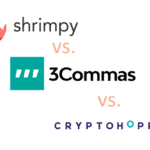The DeFi sector is growing at a staggering pace, and while it shares some similarities with CeFi, the differences are glaring too. Transparency is a significant benefit DeFi offers investors – a key factor that decides the fate of their investments.
However, DeFi projects could face a potential downfall due to the lack of accurate and reliable decentralized oracles. As was evident in recent instances during the Terra LUNA and UST collapse.
This article looks into the power of the oracles as the deciding factor in the potential success of DeFi. Let’s begin by setting the record straight.
Table of Contents
CeFi vs DeFi
By standards, centralized finance operates based on the regulations provided by central authorities. This requires CeFi service providers to be in charge of users’ funds while abiding by the Know Your Customer—KYC and Anti Money Laundering —AML policies.
Meanwhile, DeFi— decentralized finance, depends on a peer-to-peer model and smart contracts on the blockchain to execute transactions. All without human or third-party interference, thereby minimizing errors, eliminating a single point of failure, enhancing security, and increasing efficiency.
From an investor’s perspective, DeFi is a more efficient alternative as it outperforms CeFi by offering benefits like accessibility and utility of digital assets to investors.
Decentralized finance empowers investors by giving them impressive transparency in operations and credit risk — a key factor that decides the fate of their investments.
Since DeFi projects rely on oracles to function, there’s a chance that they’d fall due to the lack of accurate and reliable decentralized oracles. As we saw during the Terra LUNA and UST collapse.
What are Oracles, and why are they important?
As we have mentioned before, DeFi projects heavily rely on smart contracts on the blockchain. Smart contracts are codes programmed to self-execute transactions once predetermined agreements are met without intermediaries.
However, contrary to the name, smart contracts are limited in their “smartness.” While they can self-execute complex logic (on-chain), they can’t access off-chain (real-world) data independently, such as the price of an asset, etc.
Meanwhile, this on-chain to off-chain data communication is essential for seamless complex decision-making and execution. And here’s where Oracles make a grand appearance!
Oracles are essential tools designed to support the smooth running of blockchain networks by supplying a tamper-proof and wide array of real-world (off-chain) data to smart contracts and distributed ledger technology (DLT).
Centralized vs. Decentralized Oracles
Blockchain oracles can either be centralized or decentralized. Centralized oracles are like a central authority from which smart contracts get external data. They pose a significant risk to DeFi projects because they can be hacked and influenced due to their single point of failure. As a result, decentralized oracles such as QED were developed to tackle oracle problems.
Decentralized oracles are a group of anonymous oracles where each node and oracle independently supply secure and off-chain data to the blockchain. The drawbacks— poor transparency, unreliability, inaccuracies, delay, collateral model, of some decentralized oracles have led to the downfall of DeFi projects such as Terra Luna and UST protocol.
Thence, the top 3 decentralized oracles that offer solutions to these issues include:
QED
QED protocol was designed as an aggregator with decentralized infrastructures such as timeliness, security, reliability, accuracy, and resilience. QED protocol uses external collateral instead of a system token for collateral. This helps to avoid systematic risks and related challenges. The protocol seems to be the best-decentralized oracle built to fix the limitations of others.
Another significant feature is QED’s alpha version of the DelphiOracle program, which delivered more than 25 million data entries to multiple blockchain networks without compromising security. QED can handle 20,000 transactions per secs with a finality refresh rate of 0.5 sec.
Interestingly, when other oracles, including Chainlink, shut down during Black Thursday in March 2020, only QED functioned at optimal capacity. Thus, emphasizing the protocol’s resilience.
Band Protocol
The Band Protocol is a cross-chain oracle that connects real-world data to smart contracts.
The protocol features a BandChain, which makes it compatible with any smart contract platforms and DLTs. BandChain can retrieve data from external sources and deliver them in plain and secured format across multiple blockchains.
SupraOracles
SupraOracles is a cross-chain protocol whose mission is to build the best-performing blockchain infrastructure to back global value exchanges. The protocol is compatible with many blockchains. Like the QED, SupraOracles takes pride in providing rewards for reliable nodes. The protocol is fast with a finality of 3-5 secs data refresh rate and cross-chain interoperability.
Conclusion
QED has shown its ability to lead other oracles as it supersedes the limitations of competitions while offering advanced features and benefits. With oracles such as QED, DeFi projects can only succeed.










